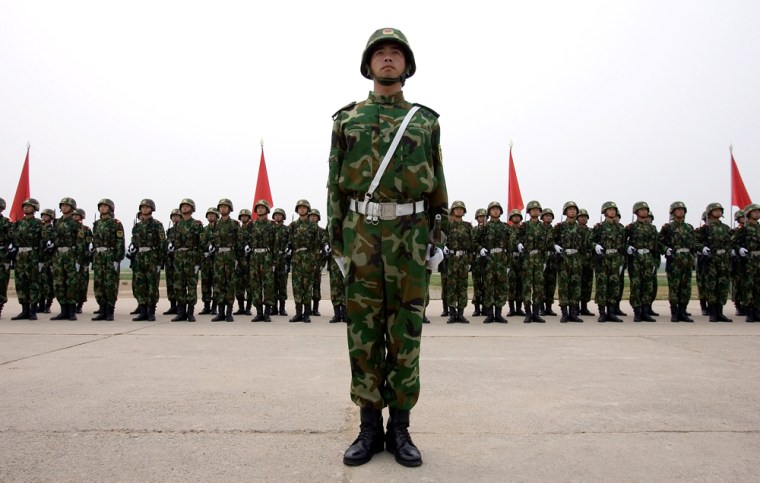China’s military is celebrating its 80th birthday Wednesday with snazzy new uniforms, lavish exhibitions and a degree of transparency for a force long swathed in secrecy.
Yet even with the public relations drive, the buildup of the People’s Liberation Army continues to stir concern among some of China’s neighbors. Observers say the new openness — touted as a sign of modernization — remains highly limited.
China’s army “is making significant efforts to improve their foreign military exchanges, but still has a long way to go in the area of transparency,” said David Shambaugh, an expert on the Chinese military at George Washington University.
“They still operate from a zero-sum mind-set that the more information that is known about the PLA, the more insecure China is,” Shambaugh said.
The military is marking its anniversary with new uniforms to update the old baggy style that has changed little in the nearly three decades since China’s economy began to take off.
An exhibition in Beijing showcases the fruits of years of double-digit increases in defense spending, transforming a military long regarded as huge but vastly outdated.
But it is the halting moves toward greater transparency that are the most striking, apparently motivated both by the demands of military modernization and the need to assuage nervous neighbors.
They began with the publication of biannual reports on the military in 1998 that have slowly grown more detailed, even while repeating threats to attack Taiwan, the self-governing island that China says is its territory.
Since then, increasing numbers of foreign observers have been permitted at military exercises. Drills and port visits have been held with the American, French, Indian and other navies, and full-scale exercises held with Russia and other Central Asian states.
Pentagon hot line
For the first time ever this year, a Chinese general attended a multilateral defense forum, surprising attendees by announcing China’s intention to set up an emergency hot line with the Pentagon. China’s Defense Ministry is also reportedly planning to appoint a media spokesman — a major step for a body that until recently didn’t even have a published phone number.
“The Chinese military is getting more and more in line with international practice, more confident and transparent,” Maj. Gen. Luo Yuan was quoted as saying in the official China Daily.
Much has yet to change, however. People’s Liberation Army leaders took the opportunity of the anniversary to recommit to their role as the ruling Communist Party’s house army, rejecting any notion of shifting loyalty to the government.
And spending for the 2.3 million-member force — the world’s largest army — continues to balloon, rising nearly 18 percent this year to $44.94 billion.
That puts China roughly in the same neighborhood as Japan, Russia and Britain in defense spending, although it spends less than one-tenth of what the U.S. military costs. The Pentagon says China’s real defense spending may be much more, because the official budget doesn’t include major weapons purchases and other items.
While China lacks many big-ticket items, such as aircraft carriers, budget increases have allowed the army to upgrade its equipment, buying billions of dollars worth of planes, ships and submarines from Russia.
New fighter jet
China this year also claimed breakthroughs in its own defense industry. In January, it blew up one of its defunct satellites with a missile-launched projectile — demonstrating it is capable of blinding high-tech armies like America’s — and unveiled its new Jian-10 fighter jet.
The new hardware has been accompanied by strategic thinking that looks increasingly beyond China’s shores. Chinese military journals espouse the need to protect seaborne trade and energy supply routes, as well as blunt the U.S. military’s overarching superiority in the Pacific.
While welcoming the growing transparency, Washington and others say the People’s Liberation Army needs to be clearer both on spending and the intentions of its military buildup.
“The pace and scope of its military modernization, particularly the development of new and disruptive capabilities such as the anti-satellite missile, could create misunderstandings and instability in the region,” said an Australian government report on national security.
In response, China has repeated the mantra that its armed forces are purely for defending its territory. Yet included in that pledge is the unshakable goal of reuniting with Taiwan, by force if necessary — something that could put it on a collision course with Taiwan’s main protector, the United States.
Too much confidence?
Experts say a conflict over Taiwan is their greatest concern. While China doesn’t entirely have the upper hand in the Taiwan Strait, its new capabilities threaten stability, not least because of the risk of miscalculation.
Lonnie Henley, an East Asia specialist in the office of the U.S. Director of National Intelligence, recently warned that China appeared to have too much confidence that it could manipulate the scale of a war with Taiwan.
“Their confidence in their ability to modulate the intensity, scope, pace, etc., of the conflict is probably misplaced,” Henley said. “That is dangerous for all concerned.”
